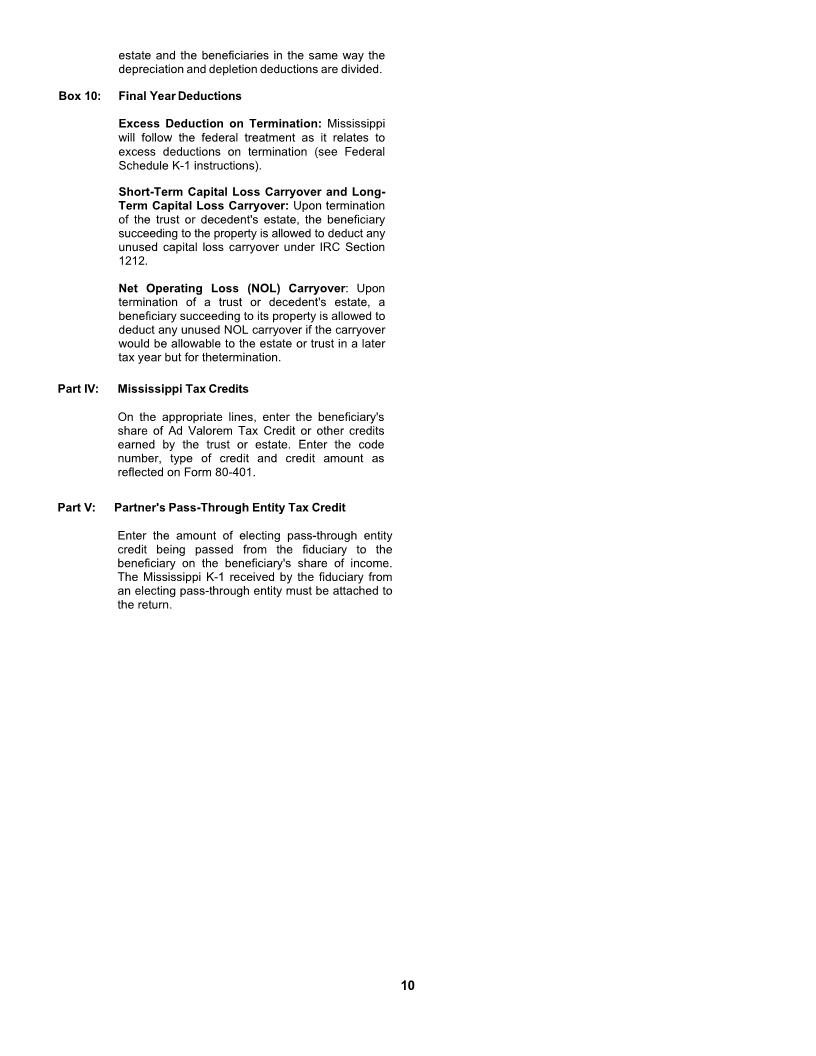- 4 -

Enlarge image
|
Complex Trust: Every fiduciary is required to file a Mississippi Fiduciary
Income Tax Return, Form 81-110, for any resident individual,
A complex trust is any trust that does not qualify as a simple trust, or estate for which he acts, or for any nonresident
trust as explained above. individual, trust, or estate for which he acts that has taxable
income or gain derived from Mississippi sources.
Grantor Type Trust:
Income from Mississippi sources includes income or gain
A grantor type trust is a legal trust under applicable state law from:
that is not recognized as a separate taxable entity for income
tax purposes because the grantor or other substantial owners a. Real or tangible personal property located in Mississippi
have not relinquished complete dominion and control over the b. A business, profession or occupation carried on within
trust. Mississippi; or
c. Services performed within Mississippi
Generally, for transfers made in trust after March 1, 1986, the
grantor is treated as the owner of any portion of a trust in which For a nonresident estate or trust, income from the following is
he or she has a reversionary interest in either the income or not considered to be derived from Mississippi sources:
corpus therefrom, if, as of the inception of that portion of the annuities, interest, dividends, or gains from the sale or
trust, the value of the reversionary interest is more than 5% of exchange of intangible personal property, unless it is part of
the value of that portion. Also, the grantor is treated as holding the income from a business, trade, profession, or occupation
any power or interest that was held by either the grantor's that is carried on within Mississippi.
spouse at the time that the power or interest was created or
who became the grantor's spouse after the creation of that BANKRUPTCY ESTATE
power or interest.
The filing of a bankruptcy petition for an individual debtor
Qualified Disability Trust:
creates a separate taxable entity known as a bankruptcy
estate. Every trustee (or debtor-in-possession) that files a
A qualified disability trust is any nongrantor trust:
Federal Income Tax Return for an individual’s bankruptcy
estate that has gross income of $10,000 or more under
1. Described in 42 U.S.C. 1396p(c)(2)(B)(iv) and established
chapter 7 or chapter 11 of the United States Bankruptcy Code
solely for the benefit of an individual under 65 years of age
must file a Mississippi Fiduciary Income Tax Return and pay
who is disabled, and
any taxes due. The debtor will remain responsible for filing
returns and paying taxes on any income that does not belong
2. All the beneficiaries of which are determined by the
to the estate.
Commissioner of Social Security to have been disabled for
some part of the tax year within the meaning of 42 U.S.C. Every bankruptcy estate of an individual required to file a
1382c(a)(3). return must have its own EIN. The SSN of the individual
debtor cannot be used as the EIN for the bankruptcy estate.
A trust will not fail to meet item 2 above just because the trust's
corpus may revert to a person who is not disabled after the
The filing of a bankruptcy petition for a partnership or a
trust ceases to have any disabled beneficiaries.
corporation debtor under chapter 7 or chapter 11 of the United
States Bankruptcy Code does not create a separate legal
ESBT (S Portion Only):
entity for tax purposes.
The S portion of an ESBT is the portion of the trust that
consists of S corporation stock and that is not treated as ELECTRONIC FILING
owned by the grantor or another person.
Users of TAP are able to:
Pooled Income Fund:
• make electronic payments
A pooled income fund is a split-interest trust with a remainder • view recent account activity and history
interest for a public charity and a life income interest retained • view tax correspondence
by the donor or for another person. The property is held in a • make address changes
pool with other pooled income fund property and does not
include any tax-exempt securities. The income for a retained Tax practitioners
Third Party Access for Tax Practitioners:
life interest is figured using the yearly rate of return earned by can have TAP access to account information for each of your
the trust. See section 642(c) and the related regulations for clients from one login. First, create your own TAP account
more information. (only one per FEIN). Once you are registered in TAP, select
"Add Access to Existing Account". Your client (taxpayer) must
Bankruptcy Estate: provide you the Letter ID and Account ID in order for you to
have access to their accounts. All accounts you set up for third
A chapter 7 or 11 bankruptcy estate is a separate and distinct party access are found under the "Other Taxpayers' Accounts"
taxable entity from the individual debtor for income tax tab in TAP. For more information on TAP, visit our website at
purposes. www.dor.ms.gov.
WHO MUST FILE?
4
|










